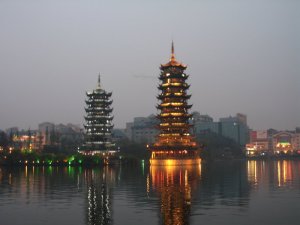Leaving Hong Kong, my first stop on the continent was the city of Guilin.
Guilin is over two thousand years old, but it doesn’t show much of its history. It’s now just a standard modern Chinese city, dirty and made up of ugly concrete buildings. This small lake-park is probably the nicest spot inside the city.
Guilin itself doesn’t have much to offer, but that was fine. I went not for the city, but for the countryside – for the otherworldly karst mountains of Song dynasty ink-on-silk paintings.
The first of only two tours I joined on my trip through China was a cruise down the Li River, as far as the town of Yangshuo. It’s a popular thing to do; boats set out one after another.
The scenery really was amazing. It’s been celebrated in paintings and poetry for centuries, and today, this particular point on the river is on the back of the 20 yuan note.
A few houses were scattered along the way, when there was land between mountain and river.
A small number of fishermen plied the river on bamboo rafts.
After four hours, the boat arrived in Yangshuo. Upon disembarking, we were immediately surrounded by dozens of people trying to sell us tourist junk, pushing their wares in our faces, grabbing at sleeves, and saying “hello” over and over. The barrage lessened as we got away from the dock, but throughout the city, you – presuming you are a foreigner – can’t walk three steps without someone trying to part you from your money. It was unpleasant.
Fortunately I didn’t spend much time there. My second and last tour was to see a bit of the country before taking a bus back to Guilin around 5pm.
First we visited an old farmhouse, well outside of town. It was an ordinary family’s house, not a scenic or historic site, but even there a few people tried to sell us postcards and useless trinkets. I imagine these were the neighbors, who weren’t so lucky as to have people paying to see their homes. The upshot is that I don’t have any pictures of the outside of the house, but it was similar to the riverside houses in the earlier photo.
I do have a shot of the front door, though.
Houses throughout China still had red paper decorations on their front doors from the lunar new year, even though it was over a month past. The mirror and scissors, meanwhile, are a local tradition meant to protect the house from wandering ghosts. The idea is that ghosts will be frightened of their own reflections, and if that doesn’t work, the scissors will fall and cut any that try to enter.
We only got to enter as far as the courtyard, but it was still fascinating.
Snake and centipede wines!
A shrine to Mao.
While city people have painful memories of the Cultural Revolution, many poor farmers in the country revere Mao for giving them ownership of their land and ending what was essentially serfdom.
After seeing the house, we went to a tributary of the Li River for a ride on a bamboo boat, including a demonstration of cormorant fishing and local folksongs.
The singing bit was sort of lame, since it was in Mandarin (and not the language that the song comes from), but the tune was local, at least.
All my shots of the cormorants in action came out blurry, but here are some resting.
That’s all for now.















